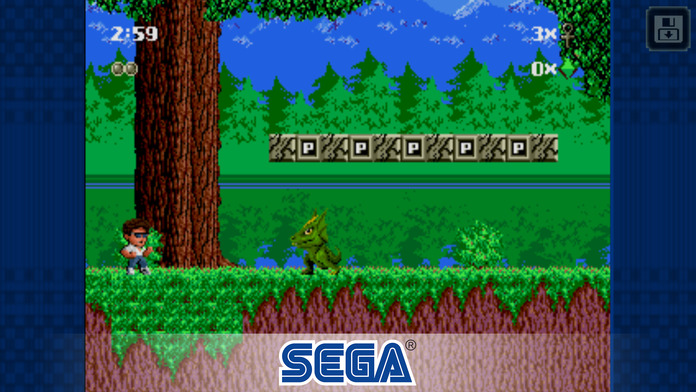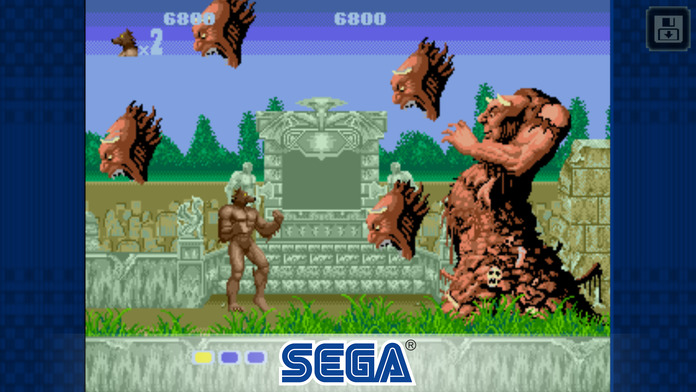 Hello everyone, and welcome to Musgravian Musings, a little space of my own where I can do some non-review reflections on recent game releases. In general, the featured games are ones that have caught my interest in some way or another, and will tend to be games that I didn’t (and won’t) review. This time, we’re looking at the handful of retro releases SEGA just put out under the marketing umbrella of SEGA Forever. SEGA had been planning this initiative for a while, so it’s obviously something they put some thought into. I just wish that showed better in the end results.
Hello everyone, and welcome to Musgravian Musings, a little space of my own where I can do some non-review reflections on recent game releases. In general, the featured games are ones that have caught my interest in some way or another, and will tend to be games that I didn’t (and won’t) review. This time, we’re looking at the handful of retro releases SEGA just put out under the marketing umbrella of SEGA Forever. SEGA had been planning this initiative for a while, so it’s obviously something they put some thought into. I just wish that showed better in the end results.
In spite of some earlier speculation that SEGA might be doing a subscription-style service under the SEGA Forever banner, it seems to have turned out to be a marketing push behind updating, releasing, and re-releasing some of their classic games with a new monetization model. The iOS platform is no stranger to SEGA classics. The company has released a number of Genesis games and a few Dreamcast over the years, with most of them having been pulled after being broken by one iOS update or another. In the past, these releases used a standard payment model. You pay an upfront price, you get the game. The quality of these releases varied wildly, of course. The Dreamcast games were generally ported and turned out quite well as a result. The Genesis games were almost all emulated through some thoroughly average emulator software. In terms of quality and the size of the line-up, SEGA definitely had room for improvement.
I don’t think I was alone in hoping that the SEGA Forever initiative would give us that improvement. Unfortunately, it’s a disappointment on virtually every possible level. They made an official announcement with a really slick trailer that seemed to promise a total celebration of all things SEGA. New releases every month! Great SEGA classics all the way through to the Dreamcast! SEGA has an amazing history in gaming, and so very much of it remains tragically unmined by the company, especially outside of Japan. Outside of a handful of Dreamcast ports, almost all of SEGA’s efforts seem to culminate in various configurations of the same 40 Genesis games we’ve been getting in collections for nearly 20 years now. They’ll throw the occasional bone to fans of their classic arcade games, and Nintendo 3DS owners certainly got a treat with the SEGA 3D Classics and the Game Gear Virtual Console, but systems like the Saturn, SEGA CD, 32X, and Master System seem to get left in the cold every time.
With that said, I was certainly disappointed when SEGA announced their starting line-up for SEGA Forever. Five Genesis games, three of which had been already released on iOS when they did this the last time. Technically, Crazy Taxi (Free) and Sonic CD (Free) could probably be considered a part of SEGA Forever, but those were also pre-existing releases. The selection of games leaves something to be desired even by the standards of the Genesis platform. Sure, Sonic (Free) is there, and I would expect him to be. But all they’ve done is taken Christian Whitehead’s fantastic port and apply a free-to-play model to it that you can buy out of. Unlike the other returning games, Sonic was already 64-bit compatible and supported all kinds of bells and whistles. What do players get out of this “update"? Nothing but an extra layer of hassle on start-up. Never mind that SEGA fumbled the ball again on making sure things would work at launch for pre-existing customers. This is the third time that’s happened, but if nothing else, they fixed it fast, I suppose.
The other four games are stranger picks. Altered Beast (Free) and Phantasy Star 2 (Free) rise from their iOS graves, having been among the previous releases that were pulled following compatibility issues. I recognize that its status as a launch window release and, for America, a pack-in with the system in its early days lends Altered Beast a lot of favor among some players, but it’s a simple game that was pretty mediocre even in its time. It got a lot of attention because it was a pretty convincing arcade port of a recent game, but games that fly on presentation alone typically don’t age well, and that’s definitely the case here. Still, I’ll give it a pass. It’s important to Genesis history, after all.
Phantasy Star 2 is clearly filling the role of the token RPG for this launch. Once SEGA’s premiere RPG brand, the Phantasy Star series has long since given up its roots as a single-player RPG to the join the exciting world of online multiplayer. The classic games are undoubtedly of their time, but they’re still a lot of fun if you approach them the right way. Nevertheless, I think SEGA missed a real opportunity here to make SEGA Forever look like the big wave they want it to be. Is it so wild to imagine that SEGA could release Phantasy Star 1 first? Yes, it’s a Master System game, but thanks to the wizardry Yuji Naka performed in programming its engine, it looks almost as good as a 16-bit game. It would be new to iOS players, and more importantly, it would send the message that this isn’t just another excuse to peel off pieces of the Genesis Collection to sell to us yet again.
Then we’ve got the iOS newcomers, and what a pair of choices these are. SEGA Technical Institute was an internal developer at SEGA of America. They’re most famous for assisting in the development of Sonic the Hedgehog 2 and co-developing Die Hard Arcade. They released five games of their own on the Genesis: Dick Tracy, Sonic Spinball, The Ooze, Kid Chameleon (Free), and Comix Zone (Free). The latter two have been selected to be on the front lines of this SEGA revolution, and they’re frankly baffling picks. Kid Chameleon is a little loose in its controls but is simple enough to work on a touch screen. But it’s also a very low-profile game, so I don’t understand how it muscled its way in ahead of things like VectorMan. Comix Zone is more famous, and it certainly has a cult following. I think it’s a pretty weak game personally, but I know many who love it. The issue here is that it’s a rather complicated game that takes to virtual buttons quite poorly. The Ghosts ‘n Goblins problem again, in other words.
Some games from other systems would have really gone a long way towards showing SEGA was serious here, and they really could have chosen more interesting Genesis games if that was something they felt they had to stick to. Imagine if they had launched with Sonic the Hedgehog 3 instead of downgrading an existing release? Dynamite Cop or Zombie Revenge instead of Altered Beast? Phantasy Star 1 or Shining in the Darkness instead of Phantasy Star 2? Maybe Outrun or Galaxy Force 2 instead of a forgettable Genesis platformer? Perhaps they’re still working on getting those games working, or maybe they just want to save some big guns for later, but it’s still underwhelming. Is this about honoring SEGA’s history, or just Genesis history?
So, whatever, the selection of titles isn’t exactly what Shaun wants. But that’s not a killer, that’s just down to personal taste. The bigger problem is that somehow, someway, SEGA is using an emulator that is worse than the one they were using in the 2009 releases. That emulator wasn’t very good to begin with either, so that’s quite the impressive feat. Adding in nine years of progress in software and hardware, it’s nearly unbelievable. While the 2009 versions ran at their proper framerate of 60 FPS on an iPhone 3GS, these new games are running at an inconsistent framerate that wavers between 30 and 45 FPS on far more powerful hardware. The fact that SEGA can’t seem to do with 2017 technology what they did with 2009 technology boggles my mind. I keep legacy iOS devices around to preserve old games, so I was able to compare Phantasy Star 2 side by side with the version it replaced, and it’s like night and day.
Then there’s the sound. This is a fairly regular issue with Genesis emulation, but one that many emulators have solved. In these games, it’s atrocious. Phantasy Star 2‘s music has been mangled. Comix Zone sounds awful. This might be the worst Genesis sound emulation I’ve seen from a SEGA-branded product, ever. The emulator is also lacking in bells and whistles. You can change any options so you’re stuck with the filtered scaling it uses. Heck, you can’t even choose to use a six-button layout, which is a real problem for Comix Zone. Again, SEGA has done far better before. There’s no excuse for this. I mean, I would love it if they included some of the advanced options from the SEGA AGES 2500 line on PlayStation 2, but in a world where I can’t even get six-button support, I’m not holding my breath. Simply put, this is a bare-bones emulator that can’t even nail down its core functions.
The problems don’t stop there, either. On top of the emulation problems, the emulator itself seems to have tremendous resource demands. The games stutter, skip, and slow down to an absurd degree at times, even on newer devices. Yes, that’s right. A Genesis emulator, something that could run well on my 1997 Pentium 120 MHz computer with 8 MB of RAM, is struggling to run smoothly on hardware with a 2017 1.85 GHz processor with 2 GB of RAM. I’ve heard bad sound emulation on Genesis emulators before, but I’ve never seen one running this poorly on any hardware. Ever. And again, none of these issues appeared in the 2009 Genesis iOS releases. But hey, the ads play just fine and buying the premium IAP seems to work, so I guess SEGA checked off all of the important boxes.

We’re not going to be reviewing these games at TouchArcade. Certainly not in their current form, anyway. If you need to place them on a scale somewhere, they fall somewhere just above the Mega Man Mobile ports and well below the Capcom arcade ports on the ol’ 2017 Inexplicably Bad Retro iOS Releases chart. You want stars? I’ve got a whole bag of ones for everything other than the Christian Whitehead port of Sonic 1. That game is still just fine, and maybe SEGA should take a good, hard look at it to see how they should be treating the rest of their precious library of classics.
To SEGA, Capcom, and anyone else pondering doing something similar: kindly stop leaving your trash on mobile’s front lawn.


